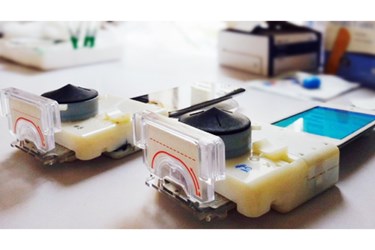15-Minute HIV Diagnosis With A Smartphone

Researchers have developed a new smartphone accessory that can analyze a finger-pricked drop of blood and offer point-of-care diagnosis for HIV or syphilis infection in 15 minutes.
The accessory, or dongle, can perform an enzyme-linked immunosorbent assay (ELISA) for three different disease markers simultaneously, replicating all mechanical, optical, and electrical capabilities of a lab-based blood test. Because the handheld device plugs into the audio jack and draws energy from the smartphone, it does not require an external power source and can be attached to any compatible device without additional downloads, according to a Columbia Univeristy press release.
The research team at Columbia’s Fu Foundation School of Engineering and Applied Sciences that designed the device was led by Samuel Sia, an associate professor of biomedical engineering. In collaboration with several other research organizations around the globe, Sia’s team launched a pilot program to test the device in Africa.
Healthcare workers in Rwanda tested the device on 96 patients who enrolled in a program aimed at preventing mother-to-child transmission of HIV. The workers attended a short training session and then walked patients through the diagnostic process.
Researchers published the findings from the pilot study in Science Translational Medicine. The test achieved a sensitivity of 92 to 100% and specificity of 79 to 100%, which the researchers claim is consistent with needs of current clinical algorithms. In addition, 97 percent of participating patients reported they preferred the device compared to laboratory-based tests because of its quick results and ease of use.
Besides ease of transport and use, cost is another significant advantage of the device. While typical ELISA equipment can cost around $18,450, Sia’s team estimates that their dongle could be manufactured for as little as $34.
“Coupling microfluidics with recent advances in consumer electronics can make certain lab-based diagnostics accessible in almost any population with access to smartphones. This kind of capability can transform how health care services are delivered around the world,” said Sia in the press release.
The World Health Organization (WHO) estimates that over 35 million people worldwide are living with HIV, and the largest portion of that population lives in sub-Saharan Africa. A 2014 Ericsson report projects that by 2019, 930 million sub-Saharan Africans will own mobile phones, and a significant number of those will be smartphones.
Image credit: Samiksha Nayak for Columbia Engineering
